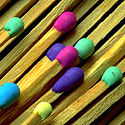 When a match is struck, friction supplies the match-head with sufficient
heat energy to enable the chemicals to react and, because the rate of heat
production by the reaction is greater than the rate of heat loss to the
environment, they burn with a flame. If a wind blows away the heat or the
chemicals are moist and friction does not raise the temperature sufficiently,
the match goes out; properly ignited, the heat from the flame raises the
temperature of a nearby layer of the matchstick and of oxygen in the air
adjacent to it, and the treated wood and oxygen react in a combustion reaction.
When equilibrium between the total heat energies of the reactants and the
total heat energies of the products (including the actual heat and light
emitted) is reached, combustion stops.
When a match is struck, friction supplies the match-head with sufficient
heat energy to enable the chemicals to react and, because the rate of heat
production by the reaction is greater than the rate of heat loss to the
environment, they burn with a flame. If a wind blows away the heat or the
chemicals are moist and friction does not raise the temperature sufficiently,
the match goes out; properly ignited, the heat from the flame raises the
temperature of a nearby layer of the matchstick and of oxygen in the air
adjacent to it, and the treated wood and oxygen react in a combustion reaction.
When equilibrium between the total heat energies of the reactants and the
total heat energies of the products (including the actual heat and light
emitted) is reached, combustion stops.
Back to the Welcome Page